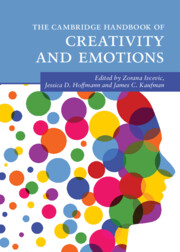Book contents
- The Cambridge Handbook of Creativity and Emotions
- Cambridge Handbooks in Psychology
- The Cambridge Handbook of Creativity and Emotions
- Copyright page
- Dedications
- Contents
- Figures
- Tables
- Contributors
- Acknowledgments
- Creativity and Emotions
- Part I Methods in the Study of Creativity and Emotions
- Part II The Development of Creativity
- 5 Affective States and Creativity
- 6 The Neuroscience of Creativity and Emotions
- 7 Attention, Affect, and Creativity, from Mindfulness to Mind-Wandering
- 8 Motivations, Emotions, and Creativity
- 9 Managing Difference and Uncertainty and Creativity
- 10 Creativity and Emotional Intelligence
- 11 Emotions across the Creative Process and across Domains of Creativity
- Part III Emotions and the Creative Person
- Part IV Emotions and Creative Products
- Part V Emotions and Creativity at School and Work
- Index
- References
11 - Emotions across the Creative Process and across Domains of Creativity
from Part II - The Development of Creativity
Published online by Cambridge University Press: 16 February 2023
- The Cambridge Handbook of Creativity and Emotions
- Cambridge Handbooks in Psychology
- The Cambridge Handbook of Creativity and Emotions
- Copyright page
- Dedications
- Contents
- Figures
- Tables
- Contributors
- Acknowledgments
- Creativity and Emotions
- Part I Methods in the Study of Creativity and Emotions
- Part II The Development of Creativity
- 5 Affective States and Creativity
- 6 The Neuroscience of Creativity and Emotions
- 7 Attention, Affect, and Creativity, from Mindfulness to Mind-Wandering
- 8 Motivations, Emotions, and Creativity
- 9 Managing Difference and Uncertainty and Creativity
- 10 Creativity and Emotional Intelligence
- 11 Emotions across the Creative Process and across Domains of Creativity
- Part III Emotions and the Creative Person
- Part IV Emotions and Creative Products
- Part V Emotions and Creativity at School and Work
- Index
- References
Summary
Emotions describe a transitory, short-term, and intense state in response to a stimulus. This state will have physiological, cognitive, and behavioral manifestations (Luminet, 2002; Scherer, 2000). It is possible to regulate an emotional state by directly interacting with the stimulus (Gross, 2007). The creative process describes the sequence of thoughts and actions that produces an idea that is both original and contextually appropriate (Lubart et al., 2015). This process is "dynamic by its components itself, their organization, their combination, the successive interactions it maintains with the environment, the unfolding nature of a phenomenon over time and its cyclical nature" (Botella & Lubart, 2019, p. 272). Thus, if we cross the definitions of the emotions and the creative process, two dynamic phenomena, we understand that they will influence each other and vary over time. But how will emotions vary during the creative process? In this chapter, we will lead a literature review to answer this question and we will also discuss these emotional variations according to the creative domain. Indeed, the process is not similar in art, science, design, theater, music, etc. (Glăveanu et al., 2013). We will see how models of the creative process integrate emotions across domains of creativity.
- Type
- Chapter
- Information
- The Cambridge Handbook of Creativity and Emotions , pp. 205 - 220Publisher: Cambridge University PressPrint publication year: 2023
References
- 2
- Cited by

